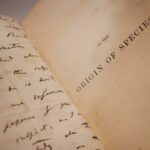The theory of evolution proposed by Charles Darwin is one of the most significant scientific theories that have shaped our understanding of life on Earth. Darwin’s theory provides a comprehensive explanation of the diversity and complexity of life forms through the process of natural selection and genetic variation. Understanding the evidence that supports this theory is crucial to appreciate the intricate workings of life and the interconnectedness of all species.
Understanding Darwin’s Theory of Evolution
The Concept of Natural Selection
At the heart of Darwin’s theory lies the concept of natural selection, often described as ‘survival of the fittest.’ This idea suggests that organisms best adapted to their environment are more likely to survive and reproduce, passing on their advantageous traits to their offspring. Over generations, these traits become more common, leading to evolutionary changes in the species.
The Role of Genetic Variation in Evolution
Genetic variation plays a pivotal role in evolution. It provides the raw material upon which natural selection acts. Without genetic variation, evolution could not occur because there would be no diversity for natural selection to work upon. Genetic variation arises from mutations, genetic recombination during sexual reproduction, and gene flow between populations.
Fossil Evidence Supporting Darwin’s Theory
Explanation of Fossil Evidence
Fossils provide tangible, historical evidence for evolution. They are the preserved remains or traces of organisms from the past and can be found in sedimentary rocks. Fossils document the existence of now-extinct species and provide insights into evolutionary changes over millions of years.
How Fossil Records Support the Theory of Evolution
Fossil records support the theory of evolution by showing a progression of life forms from simple to complex and the emergence of new species over time. They also reveal transitional forms–species that have characteristics of both ancestral and derived groups, indicating a common ancestry.
Case Studies of Significant Fossil Findings
One of the most famous fossil findings is Archaeopteryx, a transitional fossil that shows characteristics of both dinosaurs and birds, supporting the theory that birds evolved from theropod dinosaurs. Another example is the series of hominid fossils found in Africa, which show a gradual increase in brain size and changes in dentition and locomotion, suggesting an evolutionary path from early hominids to modern humans.
Biogeographical Evidence for Darwin’s Theory
Understanding Biogeographical Evidence
Biogeography, the study of the distribution of species and ecosystems in geographic space and through geological time, provides significant evidence for evolution. It reveals patterns that are best explained by evolution and the movement of tectonic plates over geological time.
Role of Geographical Distribution in Evolution
The geographical distribution of organisms around the world supports the theory of evolution. For instance, the unique wildlife of Australia, including marsupials like kangaroos and koalas, can be explained by evolution and the continent’s long isolation.
Examples of Biogeographical Evidence Supporting Darwin’s Theory
Darwin himself observed biogeographical evidence supporting his theory when he noted the unique fauna of the Galapagos Islands. He found that each island had its own type of tortoise, mockingbird, and finch, which were clearly related but had distinct adaptations to their specific environments.
Anatomical Evidence Backing Darwin’s Theory
Overview of Anatomical Evidence
Anatomical evidence includes the study of homologous and analogous structures, which support the theory of evolution. Homologous structures are body parts that are similar in structure but may have different functions in different species, suggesting a common ancestry. Analogous structures, on the other hand, have similar functions but different structures, indicating convergent evolution.
Explanation of Homologous and Analogous Structures
An example of homologous structures is the forelimbs of mammals. The human arm, the wing of a bat, and the flipper of a whale all have similar bone structures but perform different functions, indicating a common mammalian ancestor. An example of analogous structures is the wings of bats and birds. While both are used for flight, their structures are fundamentally different, suggesting they evolved independently.
Case Studies of Anatomical Evidence Supporting Evolution
The evolution of the horse, as evidenced by the fossil record, provides a clear example of anatomical evidence supporting evolution. Early horses were small, forest-dwelling animals with multiple toes. Over time, as grasslands expanded, horses evolved to be larger and faster, with a single hoofed toe for more efficient running.
Genetic Evidence for Darwin’s Theory
Introduction to Genetic Evidence
Genetic evidence for evolution comes from the study of DNA and genetic variation. All living organisms share the same basic genetic material–DNA. The similarities and differences in DNA sequences between different species provide evidence for common ancestry and evolutionary change.
How DNA and Genetic Variation Support the Theory of Evolution
The fact that all living organisms share the same genetic material suggests a common origin of life. Furthermore, the degree of similarity in DNA sequences between species often correlates with their evolutionary closeness. For instance, humans share about 98.7% of their DNA with chimpanzees, our closest living relatives.
Examples of Genetic Evidence in Evolution
One of the most compelling examples of genetic evidence for evolution is the existence of ‘junk’ DNA or non-coding DNA. These are segments of DNA that do not code for proteins but are often conserved across species, suggesting a common ancestry. Another example is the presence of endogenous retroviruses in the genomes of different species, which provide a kind of ‘molecular fossil record’ of past viral infections and can show common ancestry.
The Role of Artificial Selection in Supporting Darwin’s Theory
Explanation of Artificial Selection
Artificial selection, also known as selective breeding, is the process by which humans breed plants and animals for specific traits. This process provides a model for understanding natural selection and provides evidence that selection can lead to significant changes in populations over time.
How Artificial Selection Provides Evidence for Natural Selection
Artificial selection demonstrates how selection for specific traits can lead to significant changes in a population over a relatively short period. This process mirrors natural selection, where environmental pressures rather than human choices determine which traits are advantageous.
Examples of Artificial Selection in Action
Examples of artificial selection are abundant in agriculture. The domestication of wild plants and animals for food production has led to dramatic changes in these species. For instance, the wild ancestor of modern corn was a grass-like plant with small, hard seeds. Through selective breeding, humans have transformed this plant into the highly productive crop we know today.
The Evidence from Embryology
Understanding Embryological Evidence
Embryology, the study of the development of an organism from fertilization to birth, provides further evidence for evolution. Many organisms, including humans, go through similar stages of embryonic development, suggesting a common ancestry.
How Embryology Supports the Theory of Evolution
Embryos of different species often show striking similarities, indicating a common ancestry. For instance, fish, bird, and human embryos all have gill slits and tails at some point in their development, suggesting that these species share a common ancestor with these features.
Case Studies of Embryological Evidence
One of the most famous examples of embryological evidence for evolution is the presence of vestigial structures in embryos. For instance, human embryos have a tail and pharyngeal pouches (similar to gill slits in fish) at certain stages of development. These structures disappear as the embryo develops, but their presence suggests a common ancestry with species in which these structures are functional.
Critiques and Counterarguments against Darwin’s Theory
Overview of Common Critiques
Despite the overwhelming evidence supporting Darwin’s theory of evolution, some critiques and counterarguments persist. These often come from religious or philosophical perspectives that reject the idea of common ancestry or natural selection. Some critics argue that the theory cannot explain the complexity of life or the origin of life.
Scientific Responses to These Critiques
Scientists have addressed these critiques by pointing out that the theory of evolution does not attempt to explain the origin of life, but rather the diversity and complexity of life once it began. Furthermore, the complexity of life can be explained by the cumulative effects of simple natural processes over billions of years.
The Continued Relevance of Darwin’s Theory
How Current Research Continues to Support Darwin’s Theory
Current research in various fields, including genetics, paleontology, and molecular biology, continues to support and refine Darwin’s theory of evolution. New discoveries, such as the sequencing of the human genome and the discovery of new fossils, provide further evidence for common ancestry and natural selection.
The Impact of Darwin’s Theory on Modern Science
Darwin’s theory of evolution has had a profound impact on modern science. It provides a unifying framework for understanding the diversity of life and has influenced many fields, including medicine, psychology, and conservation biology.
Final Remarks
The evidence supporting Darwin’s theory of evolution is vast and comes from various fields of science. From the fossil record to genetic evidence, each piece of evidence builds upon the others to create a compelling case for evolution by natural selection. Understanding this evidence is crucial for appreciating the complexity and diversity of life on Earth.
Frequently Asked Questions
What is the main idea of Darwin’s theory of evolution?
The main idea of Darwin’s theory of evolution is that all species of organisms arise and develop through the natural selection of small, inherited variations that increase the individual’s ability to compete, survive, and reproduce.
What evidence supports the theory of evolution?
Evidence supporting the theory of evolution comes from various fields, including paleontology (fossils), comparative anatomy, biogeography (distribution of species), embryology (development of embryos), and molecular biology (DNA).
What is the role of genetic variation in evolution?
Genetic variation is crucial for evolution because it provides the raw material upon which natural selection acts. Without genetic variation, there would be no diversity for natural selection to work upon.
What is the difference between homologous and analogous structures?
Homologous structures are body parts that are similar in structure but may have different functions in different species, suggesting a common ancestry. Analogous structures have similar functions but different structures, indicating convergent evolution.
How does artificial selection support the theory of evolution?
Artificial selection, or selective breeding, demonstrates how selection for specific traits can lead to significant changes in a population over a relatively short period. This process mirrors natural selection, where environmental pressures rather than human choices determine which traits are advantageous.
Why is Darwin’s theory of evolution still relevant today?
Darwin’s theory of evolution is still relevant today because it provides a unifying framework for understanding the diversity of life. It continues to be supported by new research and discoveries in various fields of science.
References
- Darwin, C. (1859). On the Origin of Species by Means of Natural Selection, or the Preservation of Favoured Races in the Struggle for Life. London: John Murray.
- Futuyma, D. J. (2013). Evolution. Sunderland, MSinauer Associates.
- Mayr, E. (2001). What Evolution Is. New York: Basic Books.
- Ridley, M. (2004). Evolution. Oxford: Blackwell Publishing.
- Zimmer, C., & Emlen, D. J. (2015). Evolution: Making Sense of Life. Greenwood Village, CO: Roberts and Company Publishers.








